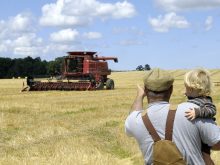Tall fescue is a perennial bunchgrass used as a forage, for erosion control and for turf.
It has a long history in the United States, where it has been grown extensively, but it is now being produced and harvested in Canada.
Since its introduction there have been cases of fescue toxicosis in cattle. In several incidents, producers were unaware of the risk associated with fescue simply because they didn’t know they were feeding the forage.
Fescue is a plant that thrives in soil that is too wet for other forage grasses. It does not do well in sandy, well-drained soil and is not particularly drought tolerant.
Read Also

Crop profitability looks grim in new outlook
With grain prices depressed, returns per acre are looking dismal on all the major crops with some significantly worse than others.
The fescue plant isn’t poisonous to cattle. Rather, toxic symptoms are caused by a fungus known as an endophyte that thrives inside fescue, making it difficult to detect.
The plant and the endophyte have a symbiotic relationship – both benefit from each other. The endophyte provides the plant with improved resistance to disease and drought, while the plant furnishes the fungus with the nutrients it needs for growth.
High levels of endophyte are commonly seen in some fescue varieties grown for turf seed. Breeders have inadvertently selected plants with the fungus because they have tried to propagate varieties that more easily tolerate drought and can resist certain types of insects. Unfortunately, these plants are also the ones that contain more endophytes.
The fescue fungus is poisonous because it produces a toxin called ergovaline. A cow that consumes as little as 400 to 700 parts per billion ergovaline in fescue can succumb to toxicity. Affected cattle can suffer from high fevers, lowered pregnancy rates, low milk production, reduced feed intake and weight loss.
In winter, cattle can be afflicted by another syndrome – fescue foot. It results because ergovaline constricts the arteries that supply blood to the feet.
This results in reduced delivery of oxygen and nutrients to the tissues of the foot. Eventually, the skin and underlying structures can die and slough. If the hoof is affected, it can detach from the foot. The ears and tip of the tail can be similarly affected.
Horses, particularly those in foal, are even more susceptible to the effects of ergovaline than cattle. When pregnant mares are fed endophyte-infested fescue, they can have poor mammary gland development, which culminates in reduced milk production.
These mares may also suffer a prolonged gestation. A lengthened pregnancy, up to two months longer, results in the development of a large fetus and usually a more difficult birth.
Live foals produced by these mares often appear retarded. They have difficulty learning how to suckle because they suffered brain damage from oxygen deprivation before and during foaling.
The only way to determine if fescue is infested with endophyte and is toxic is to test the forage for toxins. Ergovaline is a stable toxin, so it can survive for several years. Neither storage nor ensiling has been shown to reduce toxicity. However, ammoniating straw has been reported to minimize the poisonous effects of ergovaline.
Jeff Grognet is a veterinarian and writer practising in Qualicum Beach, B.C.














